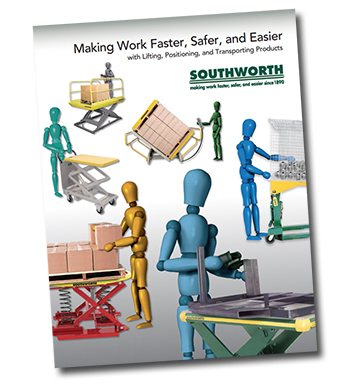Glossary of Terms
The world of material handling can be confusing for people that aren't involved in it every day. This page contains a list of common terms and definitions. We hope they will help you to better understand our products and how they work to help you improve worker safety while increasing productivity.
GLOSSARY OF TERMS AND DEFINITIONS
Access Plate: A removable cover to provide access to operating parts.
Actuator: A device for converting potential energy into mechanical energy.
Air/Hydraulic: A system which uses compressed air to run hydraulic pumps.
Angular Creep: Extremely slow speed movement of a tilter that is the result of normal, internal leakage of fluid control valves.
Angular Travel: The angular difference between the two tilting travel limits of the platform deck or forks, expressed in degrees.
Approach Ramp: A rigid structure to span a gap between the floor and a platform.
Authorized Person: Trained or qualified personnel approved or assigned to perform a specific duty or duties (see qualified person and trained person).
Automatic Landing Gate: A landing gate that automatically opens or closes, respectively, as a lift platform arrives at or departs from subject landing.
Axle Load: The dynamic load on the edge of a lift platform when a wheeled vehicle is rolled on.
Bearing: Normally a low friction needle roller or ball lined support for a rotating shaft.
Bellows Guards: Fabric like accordion skirting to enclose under the base and legs.
Bevel Toeguards: Platform sides slanted inwardly at an angle of approximately 30o from vertical in order to eliminate shear edges (commonly used in pit mounted installations).
Bleed-Off: Diversion of pressurized hydraulic fluid back to reservoir.
Bushing: The lining of an inside surface to reduce friction.
By-Pass: An alternative passage for fluid flow.
Cam Follower: A hi-capacity roller bearing used to carry or guide load.
Center of Gravity: The point at which a mass can be supported, in any position, and remain in equilibrium without tipping.
Check Valve: A valve that allows fluid flow in one direction only.
Circuit: Interconnected components through which energy or signals flow.
Clevis: A structural mounting device to support a pin (i.e. used in attaching platform to legs).
Compressibility: The change in volume of a fluid or solid when subjected to pressure.
Continuous Duty: An electric motor rated to operate continuously.
Control Transformer: An electrical device that changes the voltage of a circuit.
Control Voltage: The voltage in the lift controls circuit.
Critical Components: Those components whose absence or failure would cause the equipment, of which they are a part, to become inadequate or unsafe for its specific purposes.
Cross Tube: A welded structural crossmember between the legs of a scissors lift used to equalize loading between the legs.
Cycle: For lift tables, one complete up and one complete down operation.
Cylinder: A fluid vessel with piston and shaft that moves as fluid pressure increases or decreases.
Cylinder, Double Acting: A cylinder in which fluid force can be applied to either side of the piston.
Cylinder, Ram: A cylinder in which the piston and shaft have the same diameter.
Cylinder, Single Acting: A cylinder in which the fluid force can be applied to only one side of the piston.
Displacement: The volume of fluid a pump moves in one cycle. The volume of fluid in a cylinder at full stroke.
Dock Lift: A lift whose travel is generally 5 feet or less and which is used to load/unload material from trucks and transfer it to dock or ground elevation.
Down Valve: A hydraulic control valve which allows oil to return to the reservoir.
DU Bushing: A pre-finished, high performance bushing used at the pivot points.
Ductile: Describes material capable of sustaining not less than 5% elongation before it fractures.
Dynamic Load: A moving load.
Edge Load: The load on a platform edge as a result of off-center loading.
Electric Toeguard (toe sensor): A contact device that stops the down travel of a lift table when an obstruction is encountered.
Electric/Hydraulic: A system which converts electric power to hydraulic power.
End/Side Axle Load Capacity: The maximum amount of single axle load (in the case of rolling loads) which may be applied to the loading edge of the platform (end or side) when the lift is in its raised position.
End/Side Edge Load Capacity: The maximum amount of static load that can be applied to the edge of platform (end or side) when the lift is in any raised position.
Flow Control Valve: A valve which controls the rate of flow of hydraulic fluid.
Flow Rate: The volume of fluid passing through a pipe or hose at a given time.
Four-Way Valve: A valve which can direct fluid flow in 4 directions.
Hinged Bridge/Throw-over Plate: A hinged transition plate attached to the edge of the platform to provide a bridge to a loading dock or truck bed.
Hydraulic Piping System: The entire system of fluid conduits such as hose, pipe, tubing, etc. used to transfer hydraulic fluid between various operating components of a hydraulic system such as pumps, valves, actuators, etc.
Interlock: A device to prevent lift movement when a landing gate is not fully closed and to prevent the landing gate from being opened unless the lift platform is present at that landing.
Intermittent Duty: An electric motor rating for part-time operation.
Jog: To raise or lower the lift platform in short increments.
Landing: A permanent working surface at a fixed elevation used for loading/unloading a lift or tilter device.
Landing Gate: A gate to control personnel traffic at a landing.
Lift Table: A scissors lift device used to raise, lower, stack, convey and/or transfer material between two or more elevations and not limited to landings.
Lifting Capacity: The rated load of a scissors lift applied as a uniformly distributed load.
Limitswitch: An electrical device which, by predetermined adjustment, limits the rotational or linear movement of a mechanism.
Maintained (Contact) Control: Mode of control where movement starts when the control device is actuated and continues when the control device is released. Movement stops when either an appropriate limitswitch is actuated or the Emergency Stop button is pressed. Note: Whenever a machine's control is maintained, an Emergency Stop button must be supplied and located where it can be reached by the operator. This applies when even a portion of a machine's operating sequence includes maintained control.
Maintenance Chock: A device used to mechanically support a lift or tilter in the up position for maintenance.
Manual Control: A control actuated by the operator, regardless of the means of actuation.
Manual Override: A control that allows manual operation of an otherwise automatically controlled device.
Momentary (Contact) Control: Mode of control where movement starts when the control device is actuated and stops when the control device is released. (a.k.a. Deadman control)
Motor: A device which converts electrical energy into rotational mechanical force.
Operator: Trained person controlling the movement of the lift.
NEMA Classification: National Electrical Manufacturers Association standard.
Pantograph Leg Section: The articulated support mechanism characterized by a single pivot axis and commonly referred to as the scissors leg assembly.
Piston: A cylindrically shaped part which fits within a cylinder and is actuated by fluid pressure.
Platform Ends: The edges of the platform that are perpendicular to the scissors leg. The end dimension is considered the platform width.
Platform/Fork Length: The platform or fork dimension as measured perpendicular to the hinged edge (tilt axis). This is considered the side of the platform or fork.
Platform/Fork Width: The platform or fork dimension as measured parallel to the hinged edge (tilt axis). This is considered the end of the platform or fork.
Platform Sides: The edges of the platform that are parallel to the scissors legs. The side dimension is considered the platform length.
Pneumatic: Relating to air or another gas.
Pneumatic Piping System: The entire system of pneumatic conduits such as hose, pipe, tubing, etc. utilized to transfer air or other gas between various operating components of the pneumatic system such as pumps, valves, actuators, etc.
Point Load: A concentrated load.
Poppet: A check or one-way valve.
Pressure: Force per unit of area, usually expressed as pounds per square inch (psi).
Pressure Line: The line carrying pressurized fluid from the pump to the cylinders.
Pump: A device which causes a liquid to flow under pressure. It converts mechanical force into hydraulic pressure.
Qualified Person: A person, who by possession of a recognized degree, certificate, professional standing, or skill, and who by knowledge, training and experience, has demonstrated the ability to deal with problems relating to the subject matter, the work or the project. (See Authorized Person and Trained Person)
Quick Disconnect: A means of rapidly connecting and disconnecting electrical or hydraulic lines.
Rated Capacity: The maximum uniformly distributed load which can be applied according to the manufacturer's specification.
Rated Load: The maximum capacity as specified by the equipment nameplate.
Relief Valve: A valve that operates at a preset pressure to allow the escape of fluids.
Reservoir: A vessel for storage of hydraulic fluid which is not under pressure.
Return Line: A line used to carry hydraulic fluid from the cylinders back to the reservoir.
Rollover Capacity: The maximum amount of single-axle load which may be rolled over the platform surface when the lift is in its fully closed position.
Scissors Lift: A raising/lowering device that is supported or stabilized by one or more pantograph leg sections.
Semi-Live Portability: A lift table with non-castered wheels at one end and a wheeled skid spotter at the opposite end.
Shall: The word shall is to be understood as mandatory.
Should: The word should is to be understood as advisory.
Signal: A command to or feedback from an actuator or sensor.
Single Acting Cylinder: See Cylinder, Single Acting.
Static Load: A stationary load.
Strength Factor: The ratio of ultimate strength of a material to its design stress and maximum rated capacity.
Stroke: The length of travel of a piston or piston rod.
Strong Back: A crossmember on a scissors lift used to equalize loading between the scissors legs.
Suction Line: The hydraulic line from the reservoir to the pump inlet (suction side).
Throw-Over Plate: See Hinged Bridge/Throw-Over Plate.
Thrust Angle (Strong Back): A crossmember on a scissors lift where the cylinder pushes on to create the travel.
Torque: Twisting force (expressed in inch pounds or foot pounds).
Trained Personnel: Personnel who have been trained by a qualified person and have demonstrated the ability to perform a particular function on or around a scissors lift or tilter. (See Authorized Person and Qualified Person)
Trunnion: See Strong Back or Thrust Angle.
Two-Way Valve: A valve which can direct fluid flow in 2 directions.







